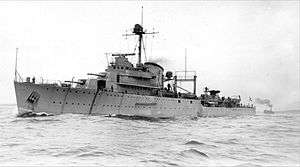Tromp-class cruiser
 Tromp in 1936 | |
| Class overview | |
|---|---|
| Name: | Tromp class |
| Builders: | Nederlandsche Scheepsbouw Mij. |
| Operators: |
|
| Preceded by: | De Ruyter |
| Succeeded by: | De Zeven Provinciën class |
| Built: | 1936–1940 |
| In commission: | 1938–1969 |
| Completed: | 2 |
| General characteristics | |
| Type: | Light cruiser |
| Displacement: | 3,350 long tons (3,404 t) standard |
| Length: | 131.95 m (432 ft 11 in) |
| Beam: | 12.43 m (40 ft 9 in) |
| Draught: | 4.32 m (14 ft 2 in) |
| Propulsion: |
|
| Speed: | 32.5 knots (37.4 mph; 60.2 km/h) |
| Complement: |
|
| Armament: | |
| Aircraft carried: | 1 × Fokker C.XIW floatplane (Tromp) |
The Tromp class was a class of light cruisers of the Royal Netherlands Navy. The hull shape was also known as the Argonaut 600. Originally the ships could not be called "cruiser" for political reasons. They were designed as "flotilla leaders" and their intended role was to be the backbone of a squadron of modern destroyers that was planned at the same time (only one of those was completed before the war broke out). The ships were ordered in 1935; Tromp was launched in 1937, and her sister ship Jacob van Heemskerk in 1939.
At the outbreak of World War II, Tromp was sent to the Dutch East Indies. Jacob van Heemskerk was still being completed in the naval shipyard in Den Helder when the German attack started on 10 May 1940, but she succeeded in escaping to the United Kingdom, where she was completed with a completely different armament set, as an anti-aircraft cruiser. Both ships served in the Far East and survived the war, Tromp to be decommissioned in 1955 and sold for scrap in 1969 and Jacob van Heemskerk to become an artillery instruction ship in 1947, decommissioned in 1969 and sold for scrap in 1970.
Ships
| Name | Laid down | Launched | Commissioned | Decommissioned |
|---|---|---|---|---|
| Tromp | 17 January 1936 | 24 May 1937 | 18 August 1938 | 20 December 1968 |
| Jacob van Heemskerck | 31 October 1938 | 16 September 1939 | 10 May 1940 | 20 November 1969 |